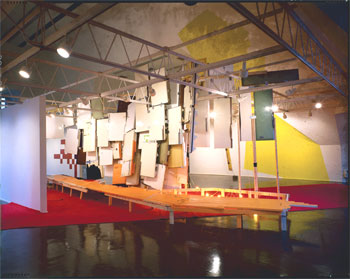|
|
|
|
|
Skin Toned Garden Mapping, 1991 Installation, The Renaissance Society at the University of Chicago, Chicago
|
Mapping TerrainIn her essay in the exhibition catalogue, Jessica Stockholder, Kissing the Wall: Works 1988-2003, Elspeth Carruthers compares Stockholder’s works to medieval maps. Mappae mundi, maps of the known world constructed in the Middle Ages and passed down through books and alter pieces. The cartographers who made these maps did not use longitude and latitude to measure distance. Instead, they used a shifting scale to reflect their interest and knowledge of the world. Rather than simply representing the topographic features of terrain in order to aid navigation, maps were made to convey an encyclopedic worldview. According to Carruthers, Circuiting, Memory, and the Medieval Mapping of Space, mappae mundi are “visually magnificent and messy narratives.” Geographic reality was subordinated to other concerns, particularly the Christian view of Jerusalem as a place of central importance. As in many of her sculptures, in Stockholder’s installations everyday objects serve as markers or signs—familiar sights that guide us through a shifting terrain, with its visual pathways that are meant to be experienced as the viewer moves through the piece. In 1991’s Skin Toned Garden Mapping, 50 hanging refrigerator doors, painted in related skin tones that are flat and even in value are formally arranged and dramatically lit. Again, Stockholder transforms familiar, generic objects by changing their setting. The composition is stacked and layered similarly to a formal garden bed. Like plants standing in rows, the doors seem to settle, shift precariously in the wind, as they hang suspended above their their “bed.” Light conditions are variable, provided by strings of light that weave through the doors. A red cloth draped on the floor reflects warm color onto the doors and the wooden platform beneath them, and adds luminosity to their opaque, milky surface. Viewers travel through a complex mapped space in which parts are carefully orchestrated. |
|
|
|
||
|
|
||


